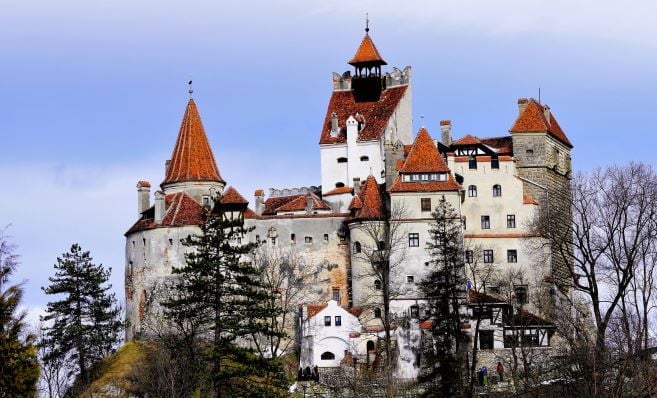Kati and I love exploring ancient ruins, castles and sites that immediately transports us back to another time and place.
For hundreds of years, majestic medieval European castles and their ruins have been an inspiration to many poets, travelers, and artists.
These monuments from a bygone age of chivalry remain a popular tourist attraction today. Even though Britain is often considered as the home of the most beautiful castles in Europe, the eastern part of the continent has many beautiful castles that remain relatively unknown to tourists.
From the forests of Romania to the rolling planes of Hungary and the hills of Slovakia, Eastern Europe hides many ancient mysteries.
Join us as we guide you on a tour of great Eastern European castles you must visit at least once.
Čachtice Castle: Uncover a 500-year-old Murder Mystery
In the wooded hills of northwestern Slovakia, perched on a hilltop overlooking the surrounding country, stands Cachtice Castle (Čachtice Castle), once a home of a powerful noble family. The castle frequently exchanged hands
Unfortunately, the castle was abandoned and had fallen into disrepair over the next few centuries. Its ruins today are one of the most popular tourist attractions in Slovakia. The good news is that the structure is relatively well-preserved. The castle’s Gothic and Renaissance features, as well as impressive stonework, will make for an unforgettable experience. It’s also a perfect spot for relaxation in nature. Even though the ruins are situated on top of a hill, the climb is rather easy and you can take a small train to the top if you still don’t feel like it.
The castle can be easily reached from the country’s capital, Bratislava, by following the European Route E-75. Alternatively, you can reach the castle from the Czech Republic or the nearby city of Trenčin.
Last but not least, Cachtice Castle is most famous for being the place of imprisonment of the infamous Hungarian noblewoman, Elizabeth Bathory, known as the ‘Blood Countess.’ We’ll let you discover the mystery of her life yourself, it’s bound to make your visit to Cachtice much more exciting.
Welcome to Bran Castle, the Home of Vlad Dracula
The myth of the blood-drinking count Dracula, the most iconic of all vampires has become an integral part of modern pop culture.
If you’re a history buff, you’re probably aware of the fact that the myth was inspired by the real historical figure, Count Vlad III of Wallachia, who later came to be known as Vlad the Impaler. Bran Castle is thought to have inspired the legend of Count Dracula but it’s a stunning place in its own right. The castle is located 25 km (15 mi) from the city of Brasov, in the historic region of Transylvania. It was built in the 14th century and later served as the residence of the Romanian royal family.
Tourist infrastructure is quite well developed in the area, so you won’t have any trouble finding accommodation. There are several charming little hotels in the nearby town of Bran, exhibiting unique local architecture and offering an excellent view of the virgin Transylvanian forest. The interior of the castle is open to tourists but you can take a guided tour to discover the castle’s rich history.
Bran Castle is open every day from 12 to 4 PM. Standard adult tickets cost 9 euros (10 $). You can pay an extra 2 euros to see the castle’s torture instruments or 4 euros to experience the castle’s unique time tunnel.
The best time to travel to Romania is either late summer or early autumn. If possible plan your trip to Bran Castle for late August and early September.
Prague Castle: One of Europe’s Most Imposing Monuments
Prague Castle lies in the very heart of the Czech capital. Its long history is closely intertwined with that of the capital and the country itself. Instead of being a single building, Prague Castle is, in fact, a castle complex, consisting of many buildings erected over a thousand-year-long period. Today, it houses the offices of the President of the Czech Republic. Officially, it is the largest ancient castle in the world, expanding over an area larger than 750,000 square feet.
There’s so much history around and so many different sights to see within the Prague Castle complex. We recommend you begin your tour by visiting the St. Vitus Cathedral, a truly remarkable structure that combines many different architectural styles. The Cathedral’s Great South Tower can be accessed by climbing 280 steps that will lead you to the top where you’ll find seven large bells, not to mention it offers a memorable view of the whole city of Prague.
The Royal Garden, an Italian Renaissance garden built in the 16th century by Emperor Ferdinand I is also a must-see. In addition to housing several elegant buildings, the park is home to many exotic plant species. Don’t miss to visit the Singing Fountain, located near the Royal Summer House.
The Old Royal Palace and the Vladislav Hall: This interesting building dates back to the Early Middle Ages but the current structure was built by the Hapsburgs in Gothic and Renaissance styles. As there are a lot of points of interest within the palace, you should take the Prague Castle Walking Tour. You might find it a bit on the pricey side but if it’s your first time to Prague Castle, it’s certainly worth the price.
Since the whole area is covered with hotels and restaurants, finding a place to stay or try out the local cuisine shouldn’t be a problem. You should keep in mind that Prague Castle is a popular tourist destination and that crowds can’t always be avoided. Prague is best to visit in spring when there are less crowds.
Experience the Timeless Charms of Budapest’s Vajdahunyad Castle
Hungary’s cosmopolitan capital is home to numerous sights that are testimony to the country’s long and vibrant history.
Close to the center of Budapest, inside the City Park, you will discover a charming little castle built in 1896 to commemorate the 1000th anniversary of the establishment of the Kingdom of Hungary. Initially made from wood, Vajdahunyad Castle was rebuilt from stone and brink at the beginning of the 20th century. It’s frequently been discovered as a ’Fairy Tale Castle’ owing to its picturesque surroundings.
The castle is actually more interesting to experience from the outside but if you still want to see the interior, you can visit the Agriculture Museum or stay outside and explore the various attractions in the vicinity.
The Gatehouse Tower: In the very middle of the park, on the shores of the lake, you’ll notice a small yet beautiful tower that looks like something straight out of a Disney movie. While the entrance to the park and the castle is free, it costs 2 euros to climb the tower wall or one of the turrets. We definitively recommend you climb to the top, from where you can see the whole neighboring area and take a memorable photo.
On the edge of the park, there’s a very cute little restaurant called the Pantlika Bistro. It’s a kiosk offering a variety of tasty street food. The famous Hungarian Palacsinta will certainly satisfy your appetite and make you fall in love with the local cuisine.
Our Final Word
We recommend that you do research before exploring any ruins but particularly a castle. Who lived there? Who fought there? What is it famous for? Those are all questions we seek to answer before traveling to any ruins but especially a castle. It will make your trip much more interesting and enjoyable. There are many castles throughout Europe, and they are all worthwhile to visit.
Related Posts
Beyond the Big Five: Discovering Wildlife Wonders in Non-African Safari Destinations
“Beyond the Big Five” takes you on a thrilling journey to lesser-known safari destinations outside of Africa. From the lush rainforests of the Amazon to the vast plains of the Pantanal in South America, this article uncovers the hidden treasures of wildlife wonders that await adventurous travelers seeking a unique and unforgettable safari experience.
Traveling the Hemingway Way: A Guide to Adventurous Exploration
“Traveling the Hemingway Way is not just about visiting destinations, but immersing yourself in the spirit of adventure. Follow in the footsteps of the legendary writer, Ernest Hemingway, as you embark on thrilling journeys, seeking out untamed landscapes, vibrant cultures, and unforgettable experiences. Get ready to embrace the thrill of exploration like never before.”
Cruises vs. Authentic Adventures: The Great Travel Debate
Explore the pros and cons of both cruise vacations and authentic adventures in this travel debate. From the all-inclusive luxury of cruises to the immersive experiences of off-the-beaten-path adventures, discover which travel style suits your preferences and offers the most rewarding experiences.










0 Comments